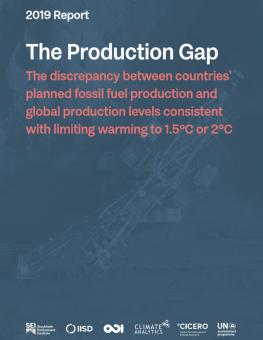
The Production Gap: The discrepancy between countries’ planned fossil fuel production and global production levels consistent with limiting warming to 1.5°C or 2°C
This report aims to expand that discourse and provide a metric for assessing how far the world is from production levels that are consistent with global climate goals.
-
Governments are planning to produce about 50% more fossil fuels by 2030 than would be consistent with a 2°C pathway and 120% more than would be consistent with a 1.5°C pathway.
-
Planned levels of fossil fuel production are inconsistent with the collective #climate pledges under the #ParisAgreement. As a consequence, the global production gap is even larger than the already-significant global emissions gap.
Key Messages
- Governments are planning to produce about 50% more fossil fuels by 2030 than would be consistent with a 2°C pathway and 120% more than would be consistent with a 1.5°C pathway.
- These planned levels of fossil fuel production are also inconsistent with the collective climate pledges under the Paris Agreement. As a consequence, the global production gap is even larger than the already-significant global emissions gap.
- The continued expansion of fossil fuel production—and the widening of the global production gap—is underpinned by a combination of ambitious national plans, government subsidies to producers, and other forms of public finance.
- Several governments have already adopted policies to restrict fossil fuel production, providing momentum and important lessons for broader adoption.
- International cooperation plays a central role in winding down fossil fuel production.
This report addresses the necessary winding down of the world’s production of fossil fuels in order to meet climate goals. Though coal, oil, and gas are the central drivers of climate change, they are rarely the subject of international climate policy and negotiations. This report aims to expand that discourse and provide a metric for assessing how far the world is from production levels that are consistent with global climate goals.
Specifically, this first Production Gap Report assesses the discrepancy between government plans for fossil fuel production and global production levels consistent with 1.5°C and 2°C pathways. This production gap tells us the magnitude of the challenge.
The report reviews, across 10 fossil-fuel-producing countries, the policies and actions that expand fossil fuel production and, in turn, widen the gap. It also provides policy options that can help countries better align production with climate goals. This is especially relevant over the next year, as countries prepare new or updated nationally determined contributions (NDCs), which set out their new emission reduction plans and climate pledges under the Paris Agreement.
This report is a product of collaboration among SEI, IISD, ODI, Climate Analytics, CICERO and UNEP.
You might also be interested in
At long last, Canada restricts oil and gas subsidies (except for all the loopholes)
Environment and Climate Minister Steven Guilbeault has unveiled detailed plans to phase out "inefficient" oil and gas subsidies, based on guidelines released yesterday morning that take effect immediately and are meant to fulfill a 14-year-old pledge by G20 countries.
Heatwaves to hit China once every 5 years as global extreme weather events multiply, study finds
Record-breaking heatwaves that have scorched North America, Europe and China are set to worsen in future unless the world stops burning fossil fuels, according to a study by the World Weather Attribution (WWA) academic initiative.
Canada to Cut Oil & Gas Subsidies
The Canadian federal government has implemented a framework to revoke subsidies for fossil fuels that are deemed inefficient. However, the framework lacks details on the specific subsidies to be eliminated and does not provide a dollar amount for the cuts. Canada, as the fourth-largest oil producer in the world, is the first country to comply with a 2009 pledge made by the Group of Twenty (G20) nations. The government plans to exempt oil and gas projects that have plans to reduce emissions and utilize carbon capture and storage (CCS) technology. Federal Environment Minister Steven Guilbeault stated that the objective is for federal support to be directed only towards projects that decarbonize the sector and result in significant greenhouse gas emissions reductions.
Canada Bans Some Fossil Fuel Subsidies, Meeting Decade-Old G-20 Pledge
Canada revealed new rules to ban some fossil fuel subsidies, targeting those that unfairly advantage oil and gas, solely support sector activities or endorse consumption of fuels that worsen climate change.